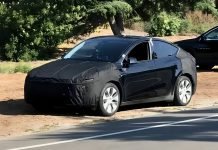The Tesla Semi has been a groundbreaking innovation in the transportation industry. With a promised range of 500 miles on a full charge, it represents a significant step towards sustainable freight transportation. This range is not just a theoretical figure, it’s based on real-world testing with the truck fully loaded at 82,000 pounds gross combination weight. The 500-mile range has been a focal point of discussion, sparking interest and curiosity among both enthusiasts and skeptics.
While the Tesla Semi’s range has been applauded by many, it has also been met with skepticism and criticism. The debate centers around the truck’s practicality, particularly in winter conditions where electric vehicles are known to suffer range loss. Critics argue that the range might not be sufficient for long-haul trucking, especially in regions with harsh winters. They point to potential issues like battery efficiency loss in cold temperatures, raising questions about the Semi’s ability to replace traditional diesel trucks.
According to recent studies and real-world testing, the Tesla Semi can be a suitable replacement for approximately 87% of semi-truck loads, even considering winter range loss. This introduction sets the stage for a comprehensive exploration of the Tesla Semi’s 500-mile range, its performance in winter conditions, and its potential to revolutionize the freight transportation industry.
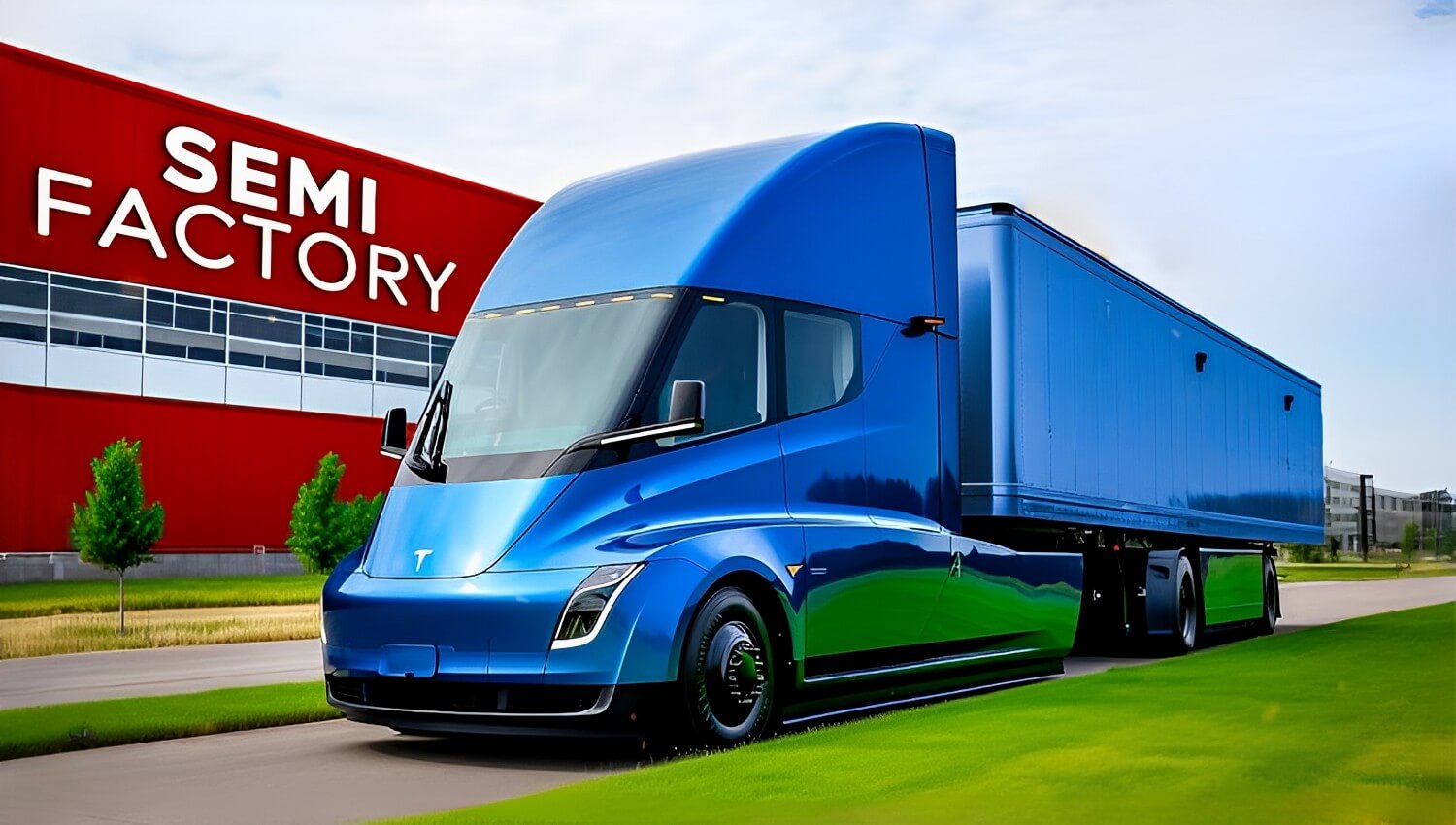
Table of Contents
Tesla Semi 500-Mile Range Understanding
The Tesla Semi’s 500-mile range is not a figure based on the truck being empty or carrying a minimal load. Instead, this range is calculated when the truck is fully loaded at 82,000 pounds gross combination weight. This specification is crucial as it reflects the real-world scenario where semi-trucks are typically used to transport heavy loads. Tesla’s commitment to providing this range under full load conditions demonstrates the company’s confidence in the Semi’s capabilities and its relevance to the trucking industry.
Tesla Semi Range With Full Load
Interestingly, real-world tests have shown that the Tesla Semi might be capable of exceeding the 500-mile range. During a delivery event last year, Tesla demonstrated this range in a 500-mile drive from Fremont to San Diego, California. The battery state of charge percentages revealed that only around 93% of the battery capacity was used to make the 500-mile trip.
This evidence suggests that the Semi could potentially go even further under certain conditions, adding to its appeal as a practical alternative to diesel trucks.
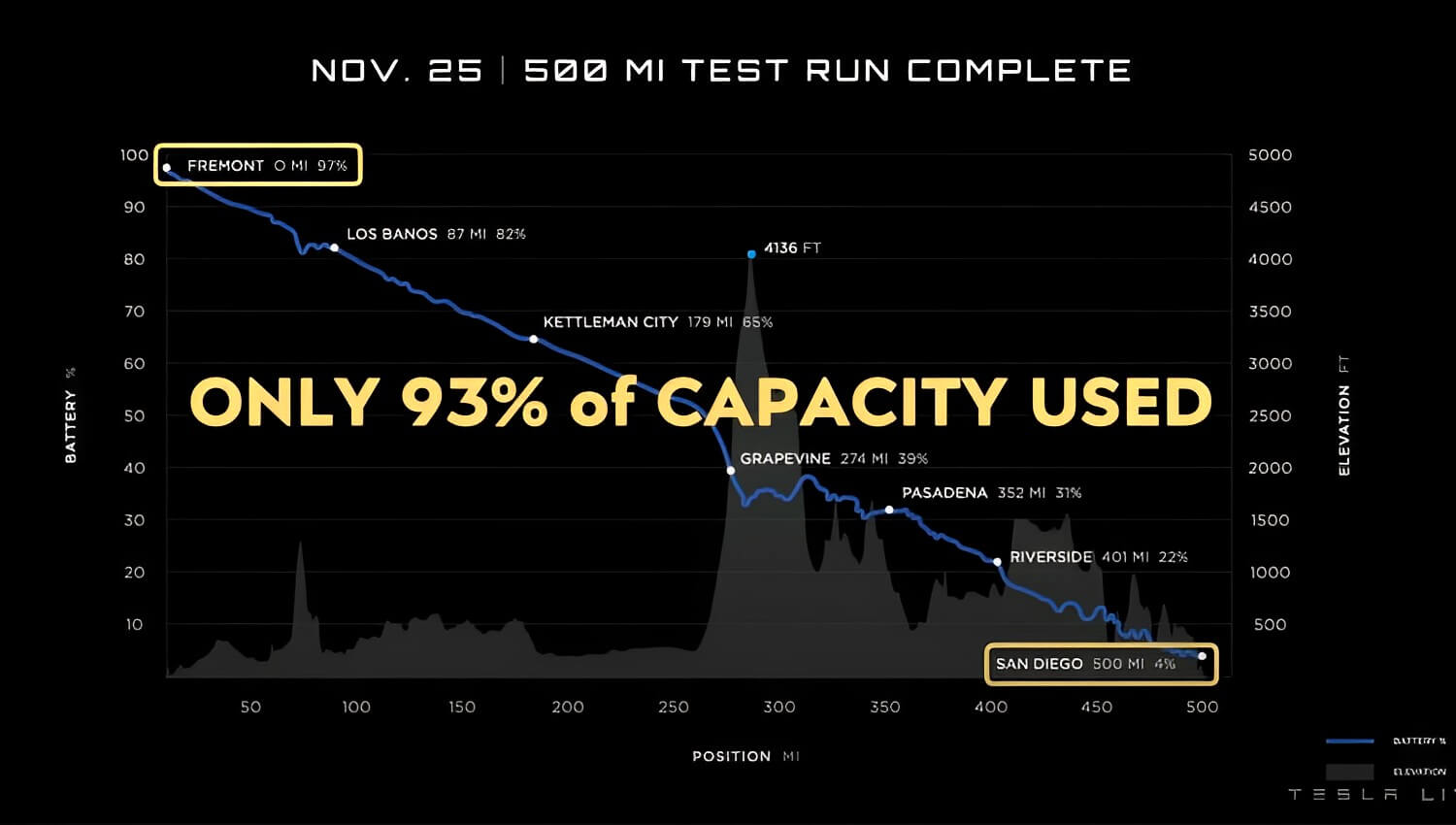
Tesla Semi Regenerative Braking
One of the factors contributing to the Tesla Semi’s impressive range is its ability to handle elevation changes efficiently. The aforementioned 500-mile drive was not a flat journey; it featured serious elevation changes and steep roads to climb. However, much of the extra energy needed to ascend was regained on the way back down, thanks to the Semi’s regenerative braking system.
This technology captures the energy typically lost during braking and feeds it back into the battery, enhancing the truck’s overall efficiency. It’s a feature that not only contributes to the Semi’s range but also represents a broader shift towards energy-conscious design in the automotive industry.
Tesla Semi Real World Test: PepsiCo’s Experience
PepsiCo, one of the world’s leading food and beverage companies, has taken a significant step towards sustainable transportation by investing in Tesla Semis.
Ownership of Tesla Semis by PepsiCo
PepsiCo’s experience with the Tesla Semi extends beyond mere ownership, the company actively uses these electric trucks in longer routes, covering distances up to 450 miles. This real-world application demonstrates the Semi’s capability to handle substantial distances, even under full load conditions. PepsiCo’s utilization of the Tesla Semi in such routes provides valuable insights into the truck’s performance, reliability, and efficiency, reinforcing the argument that it can be a viable replacement for traditional diesel trucks.
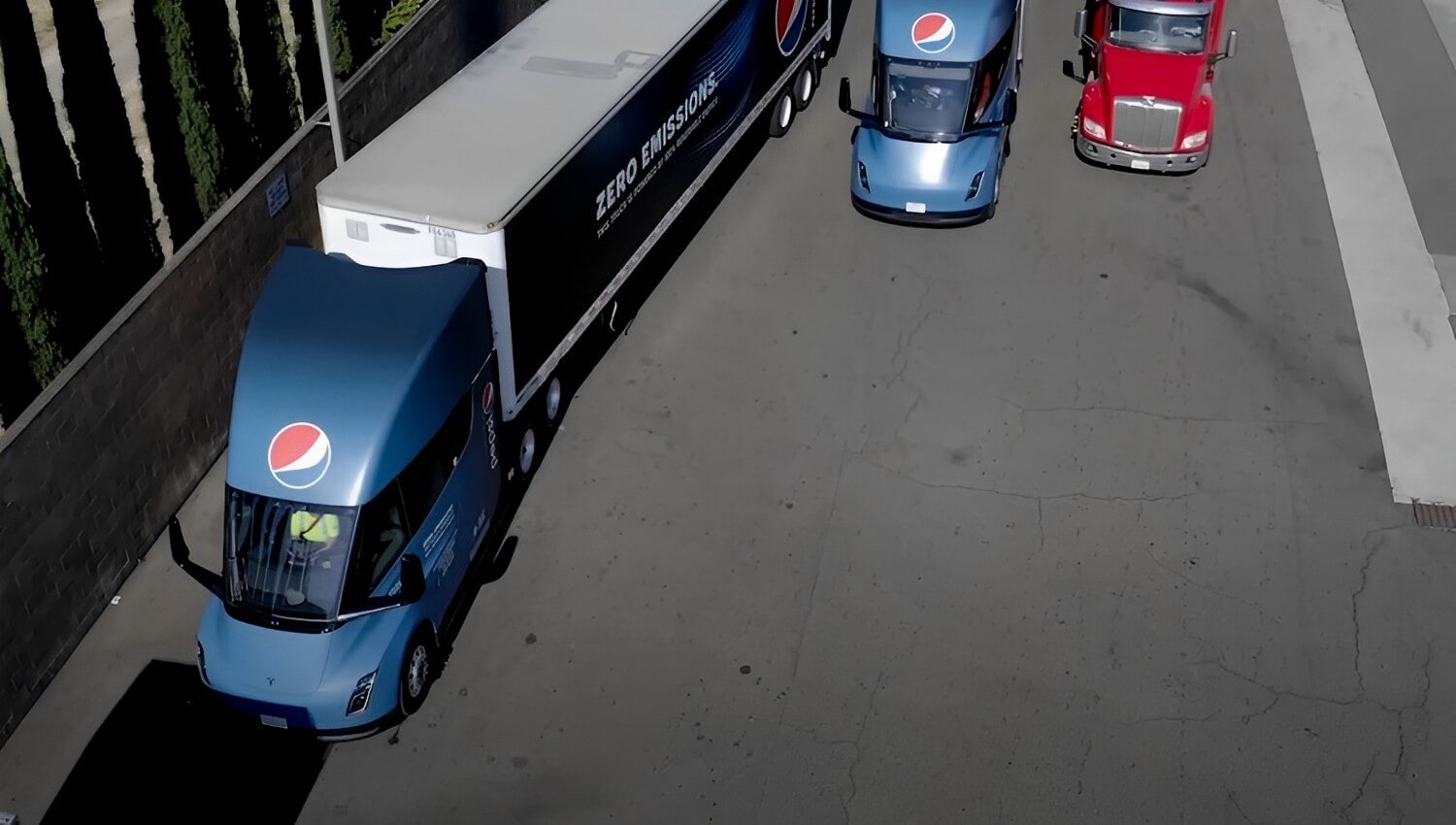
Validation by NACFE
PepsiCo’s positive experience with the Tesla Semi has been further validated by the North American Council for Freight Efficiency (NACFE). Based on information presented in a video published by NACFE and comments from industry experts, it’s clear that the Tesla Semi’s performance has met or exceeded expectations. NACFE’s endorsement adds credibility to the real-world applicability of the Tesla Semi, providing an authoritative perspective that supports the truck’s potential to revolutionize the freight industry.
Tesla Semi Cold Weather Performance
Winter driving presents unique challenges for all vehicles, and electric trucks like the Tesla Semi are no exception. Critics have pointed to potential issues such as reduced range and performance in cold temperatures. Concerns about the Semi’s ability to function effectively in winter conditions have been a significant point of debate, raising questions about its practicality as a year-round solution for freight transportation.
EV Range Loss in Cold Weather
Electric vehicles are known to experience range loss in cold temperatures, and the Tesla Semi is no different. At 10°F, the efficiency of Tesla’s vehicles drops to around 60%, leading to an expected 40% loss in range. For the Tesla Semi, this could mean a reduction from 500 miles to approximately 300 miles. This range loss is a critical consideration for operators planning long-haul routes during winter months.
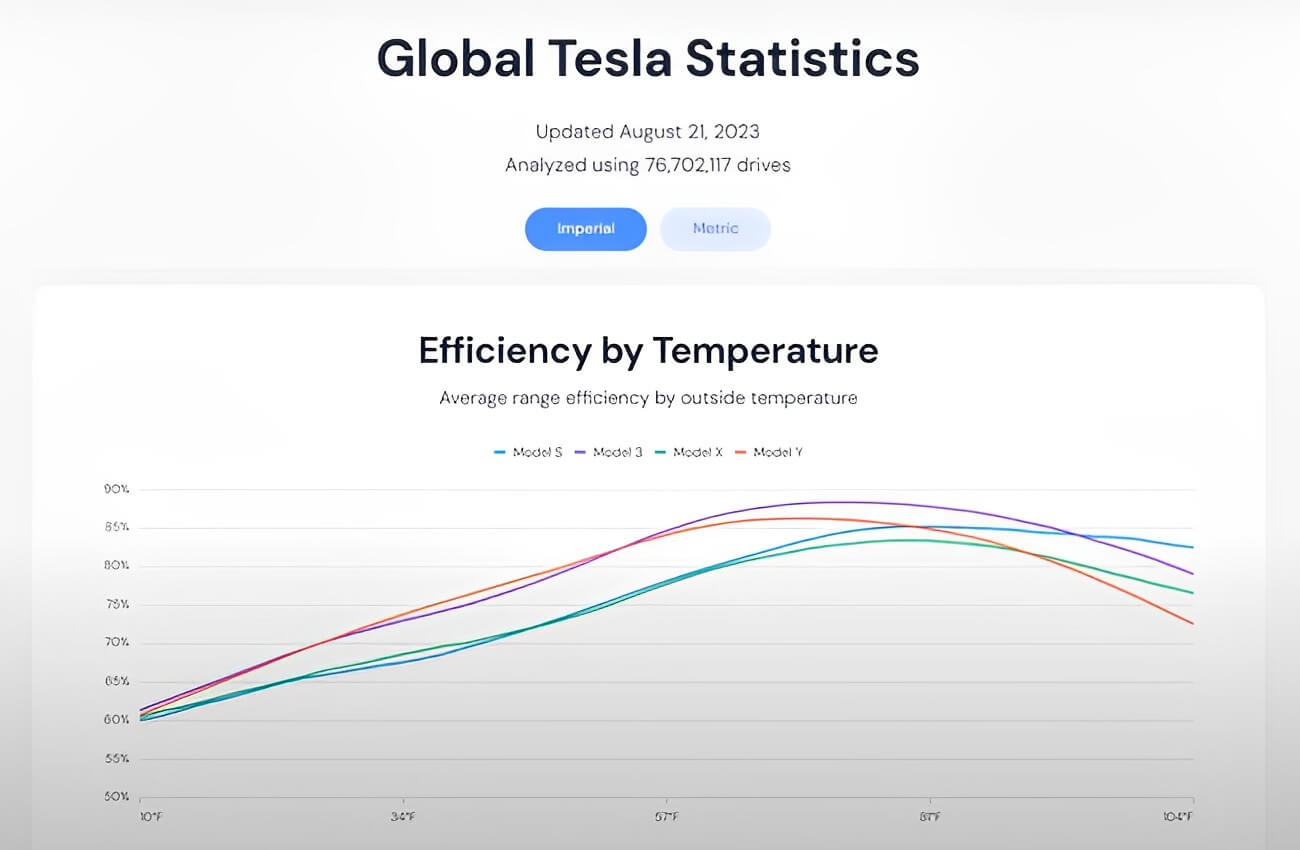
Despite the challenges posed by cold weather, the Tesla Semi is equipped with advanced battery temperature management systems that minimize range loss. This technology ensures that the battery operates within an optimal temperature range, preserving its efficiency even in frigid conditions. The ability to predict and manage the range loss allows dispatchers and drivers to plan accordingly, adding a layer of reliability to the Semi’s winter performance.
Improved Traction and Torque Vectoring
The Tesla Semi’s design offers additional advantages in winter driving, including improved traction and torque vectoring. The weight distribution of the batteries enhances traction, while the smooth application of torque and independent motors on each wheel allow for precise control. These features contribute to better handling and safety on snow and ice, addressing some of the traditional challenges faced by semi-trucks in winter conditions.
Comparison With Diesel Trucks’ Winter Issues
It’s essential to recognize that traditional diesel semi-trucks also face winter-related challenges, including fuel gelling, efficiency loss, and the need for additives and heaters. Some diesel trucks experience a 20% or more reduction in short-haul fuel economy during winter, considering all complications. The comparison between the Tesla Semi and diesel trucks in winter reveals that both have their unique challenges, but the Semi’s technological advancements offer solutions that can mitigate many of these issues.
Tesla Semi vs. Diesel Semi
The Tesla Semi’s range is subject to variations depending on the season. In summer, maintaining good battery health might limit the usable range to 400 miles, while in winter, the range could drop to around 240 miles. These considerations are essential for planning and demonstrate the need for a nuanced understanding of the Semi’s range capabilities across different conditions.
Insights from professional semi-truck drivers provide valuable context to the discussion of range. Experienced drivers have shared their perspectives on traditional diesel semi-trucks’ winter issues, such as fuel gelling and efficiency loss. Their feedback underscores the complexity of winter driving and offers a balanced view that acknowledges the challenges faced by both electric and diesel trucks.
Diesel semi-trucks are not immune to winter-related efficiency losses. Factors such as fuel additives, increased idling, and the need for heaters can lead to a 20% or more reduction in short-haul fuel economy. This comparison with diesel trucks highlights that range and efficiency challenges are not unique to electric vehicles, emphasizing the broader context of winter driving for the freight industry.
A recent report from energy.gov provides a compelling perspective on the Tesla Semi’s range. According to the report, 87% of all truck freight tonnage was shipped less than 250 miles. This statistic reveals that even with conservative battery management and winter range loss, the Tesla Semi’s range is sufficient for the vast majority of freight needs. It provides a data-driven argument that supports the Semi’s practicality for most loads.
Considering all the factors, including range variations, feedback from drivers, diesel truck comparisons, and statistical data, the evidence strongly suggests that the Tesla Semi can replace diesel semis for the majority of freight. Its design, technology, and performance make it a viable option, even in challenging conditions. While there may be specific cases where the Semi may not be the perfect fit, the overall picture points to its substantial potential as a no-compromises replacement for traditional diesel semi-trucks.
Conclusion
The Tesla Semi’s 500-mile range, coupled with its innovative design and technology, positions it as a groundbreaking solution in the freight transportation industry. Its real-world performance, as demonstrated by companies like PepsiCo and validated by industry experts, supports its practicality as a no-compromises replacement for diesel semi-trucks.
While acknowledging that there may be specific cases where the Tesla Semi may not be the perfect fit, the evidence overwhelmingly suggests that its range is sufficient for the vast majority of semi-truck loads, even considering seasonal variations and winter challenges.
The Tesla Semi is a viable and practical alternative to traditional diesel semi-trucks. Its ability to handle long distances, elevation changes, and winter conditions, along with its energy-efficient features like regenerative braking, makes it a compelling choice for the future of freight transportation. The insights and data presented in this article affirm the Tesla Semi’s potential to revolutionize the trucking industry, paving the way for a cleaner and more sustainable future.





